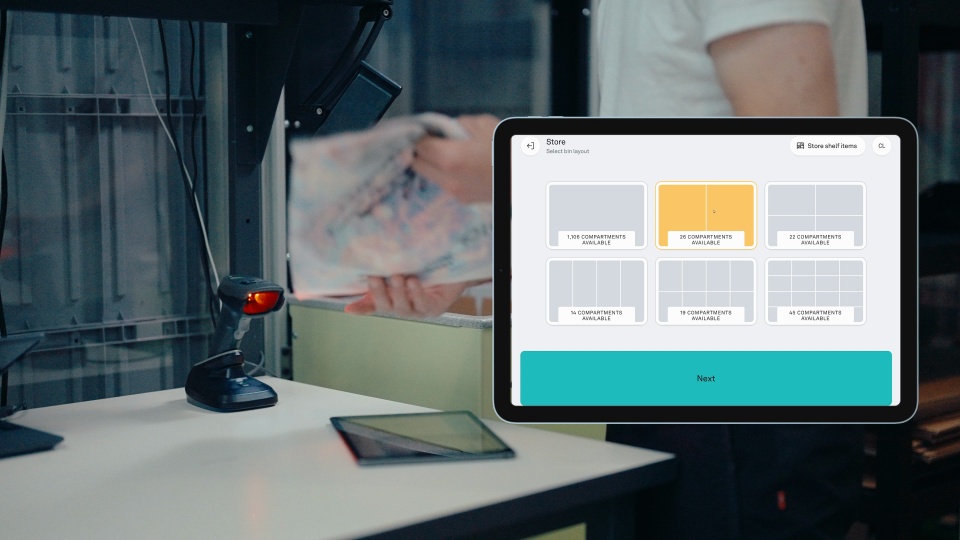To achieve this, warehouses must operate at the highest possible level, consistently delivering products with precision and without delay to ensure customer satisfaction and promote growth.
Artificial Intelligence (AI) and the Internet of Things (IoT) have been instrumental in keeping up with the ever-evolving landscape of logistics and supply chain management, allowing warehouses of all sizes to keep up with even their biggest competitors.
How exactly have these technologies managed to transform warehouse management in such a short space of time?
Let’s first explore the role of each technology in warehouse management and then examine their combined influence in shaping the future of logistics for the modern consumer.
The Internet Of Things: Warehouse Management
The Internet of Things refers to the interconnected network of physical devices, sensors, and other objects that collect and exchange essential data within a warehouse.
IoT allows warehouse managers to make data-driven decisions to optimize how their workspace functions and flows.
This technology has brought traditional operations into the future by transforming them into smart warehouses, driving efficiency and precision in handling inventory and the supply chain.
How The Internet Of Things Is Revolutionizing Warehousing
The impact IoT has already had on advancing warehouse management systems cannot be understated.
Let’s look at the core benefits of IoT to warehouse managers, which make these rapid developments possible.
- Real-time tracking: The sensors installed in warehouse products, pallets, and equipment allow for real-time inventory tracking so that warehouse managers can precisely locate goods at any given time.
- Inventory management: IoT-enabled RFID (Radio-Frequency Identification) tags monitor inventory levels and send alerts when specific products are low in stock, automating inventory management and minimizing error.
- Predictive maintenance: IoT enhances the efficiency of overall operations by detecting when specific machinery requires maintenance, reducing the risk of vital equipment breaking down unexpectedly and keeping things running smoothly.
- Environmental monitoring: IoT sensors monitor conditions like temperature, humidity, and air quality to ensure goods are preserved in ideal conditions.
- Enhanced security: Suspicious activity or security threats can be detected by IoT technology, allowing warehouse managers access to real-time surveillance and improving warehouse security overall.
Next, let's dive into the use of Artificial Intelligence in warehouse management systems.
AI: Warehouse Management
While IoT technologies collect a vast amount of data, artificial intelligence leverages this vital information to develop actionable insights.
AI can analyze massive amounts of information at lightning speed, making dealing with logistics immeasurably more straightforward for warehouse managers.
Warehouse automation is an essential part of managing the movement of goods within and out of any warehouse. It has only been made possible thanks to the integration of artificial intelligence into warehouse management systems.
How AI Is Transforming Warehousing
- Demand forecasting: AI rapidly analyzes factors like sales data, buyer habits, and seasonality to forecast demand so warehouses can manage inventory and stock more accurately throughout the year.
- Route optimization: Shipping routes are analyzed and optimized to reduce transportation time and costs, ensuring supply chain efficiency and customer satisfaction.
- Inventory optimization: AI can dynamically adjust inventory levels based on real-time demand, reducing the risk of overstocking and the need for excessive manual labor.
- Quality control: AI-powered systems minimize the need for manual quality control checks by inspecting the quality of products automatically to ensure all inventory is kept in the best possible condition.
- Robotics and automation: Robots and autonomous vehicles take the stress out of inventory management by taking over tasks like picking and packing, handling them with greater precision and speed while reducing labor costs.
The Combined Power Of IoT And AI
Artificial Intelligence and the Internet of Things are fundamental to maintaining high-functioning, innovative warehouses.
When the two technologies are combined, their true potential is brought to life, taking warehouse management to a whole new level.
Let’s discover how AI and IoT are reshaping the logistics industry by making warehouses smarter, more efficient, and more responsive to the growing demands of modern consumerism.
1. Predictive Analytics
IoT sensors collect data, while AI processes and analyzes it in real-time to be used strategically in operations.
Predictive analytics allow warehouse managers to streamline inventory management by identifying potential stock shortages, effectively monitoring supply chains, and even predicting equipment failures before they occur by foreseeing maintenance needs.
2. Automatic Decision-Making
AI algorithms, empowered by IoT data, can make autonomous decisions pre-approved by warehouse management.
For example, when handling goods that require storage within a specific temperature range in food or pharmaceuticals, AI can automatically adjust the climate control settings if it detects a temperature change.
3. Dynamic Resource Allocation
AI can optimize the flow of resources within a warehouse to respond to real-time data from IoT devices.
Forklifts can be rerouted to areas with the highest demand at any given time, reducing congestion on the warehouse floor and enhancing the overall efficiency of warehouse operations.
4. Adaptive Inventory Management
Detailed information gathered by IoT technologies allows AI to create data-driven inventory strategies.
This allows warehouse management systems to prioritize the flow of goods based on crucial elements such as buyer demand or expiration dates to keep things running smoothly, minimize the potential for human error, and streamline inventory management.
5. Continuous Improvement
What is truly so special about the combination of AI and IoT in warehousing is their potential for continuous improvement, and the capacity to adapt to meet buyer demands quickly.
These systems can rapidly refine their algorithms based on sales patterns and supply chain data to ensure every element of warehouse operations is optimized for efficiency, precision, and productivity.
Streamline Your Warehouse Operations And Supply Chain Management With Pio
At Pio, we’re leveling the playing field for warehouses of all sizes by making advanced warehouse automation technology accessible to SMBs. We offer a scalable solution to suit the size of your warehouses that grow with you as your business expands in response to the efficiency of your output.
Interested in trying our automated warehouse solution for yourself? Our systems are super quick and easy to integrate, so why wait? Get in touch today to discuss your needs for your warehouse and take the headache out of logistics for good.


.jpg?width=1920&name=pio_foto%20(68%20of%2082).jpg)


.jpg?width=600&name=Beauty-Welness-Pio-04743%20(1).jpg)